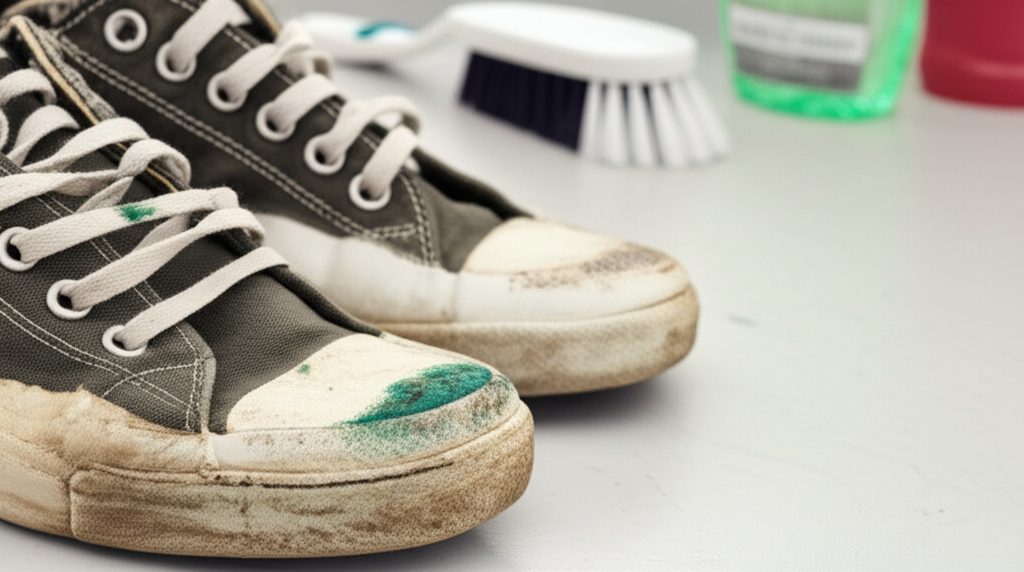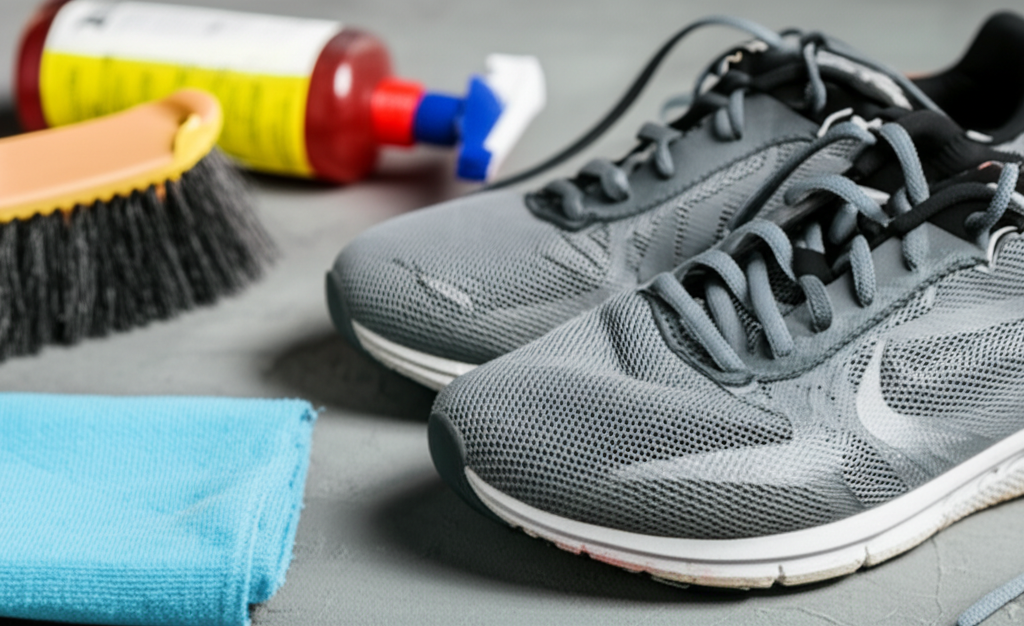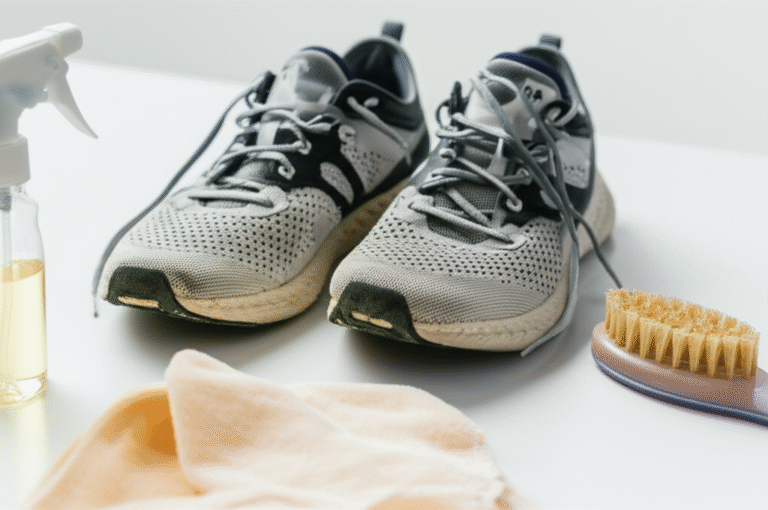Mold can be a stubborn shoe problem, but with this effortless guide on how to clean moldy shoes, you’ll banish unsightly spots and unpleasant odors, restoring your footwear to its former glory. Don’t let mold ruin your favorite pairs; simple, effective methods are within reach.
Key Takeaways
- Identify mold type and affected materials.
- Gather necessary cleaning supplies.
- Test cleaning solutions on inconspicuous areas.
- Clean gently, avoiding abrasive scrubbing.
- Ensure thorough drying to prevent recurrence.
- Prioritize ventilation during cleaning.
How to Clean Moldy Shoes: An Effortless Guide
Seeing mold on your shoes can be disheartening. Whether they’ve been stored in a damp closet or exposed to moisture, those fuzzy green, black, or white spots are unwelcome guests. Many people find cleaning moldy shoes confusing, worried about damaging their beloved sneakers, leather boots, or delicate suede shoes. But don’t despair! This guide will walk you through simple, effective steps to tackle mold, no matter the shoe material. We’ll cover what you need, how to clean safely, and how to prevent mold from returning. Get ready to bring your shoes back to life and step out with confidence!
Understanding Shoe Mold: What You’re Dealing With

Before we dive into cleaning, it’s helpful to understand what you’re up against. Mold is a type of fungus that thrives in moist, dark, and warm environments. It feeds on organic materials, which is why your shoes, made from leather, canvas, rubber, and synthetics, are perfect hosts.
There are different types of mold, but for home cleaning purposes, you don’t need to be a mycologist. The key is to recognize that it’s a living organism that needs to be killed and removed. Mold can appear as:
- Fuzzy patches in various colors (green, black, white, gray, orange).
- Dark spots that might look like stains.
- A musty smell even if visible mold isn’t apparent.
The material of your shoes will significantly influence the cleaning method. Some materials, like canvas and synthetic mesh, are more forgiving, while others, such as leather and suede, require a gentler approach to avoid damage.
Gather Your Cleaning Arsenal: Essential Supplies
Having the right tools makes the job much easier. Here’s a list of common household items and specialized cleaners that will help you win the battle against shoe mold.
General Cleaning Supplies:
- Soft-bristled brush (an old toothbrush or a dedicated shoe brush works well).
- Microfiber cloths or soft rags for wiping and drying.
- Bowl or bucket for mixing cleaning solutions.
- Gloves to protect your hands.
- Face mask to avoid inhaling mold spores.
- Newspaper or paper towels for stuffing shoes and absorbing moisture.
Mold-Killing Cleaning Agents:
Choose one or a combination based on your shoe material and the severity of the mold.
- Mild Soap and Water: For light mold on durable materials. Use a pH-neutral soap like dish soap or a specialized shoe cleaner.
- White Vinegar: A natural disinfectant and mold killer. Its acidity breaks down mold.
- Rubbing Alcohol (Isopropyl Alcohol): Effective at killing mold and also helps with disinfection.
- Hydrogen Peroxide (3% solution): A mild bleach that can kill mold and help lift stains. Use with caution on colored materials.
- Baking Soda: Great for absorbing odors and can be used as a gentle abrasive paste.
Important Note on Bleach: While chlorine bleach kills mold, it’s generally too harsh for most shoe materials and can cause discoloration and damage. It’s best to avoid it unless explicitly recommended for a specific material and situation, and even then, use it diluted and with extreme care.
You can find specialized shoe cleaning kits at most shoe stores or online retailers. These often contain brushes, cleaning solutions, and protectors tailored for different materials.
Step-by-Step Guide: How to Clean Moldy Shoes

This section breaks down the cleaning process into manageable steps. Always start with the gentlest method and escalate if necessary. Remember, patience is key!
Step 1: Preparation and Safety First
Ventilation is Crucial: Always clean your shoes in a well-ventilated area, preferably outdoors or near an open window. Mold spores can be harmful if inhaled.
Protect Yourself: Wear gloves and a face mask to prevent skin contact and inhalation of mold spores.
Remove Loose Debris: Use a dry brush to gently brush away any loose dirt, dust, or visible mold. Do this outdoors to avoid spreading spores inside your home. Be gentle, especially on delicate materials.
Stuff the Shoes: Remove the insoles and laces. Stuff the shoes loosely with newspaper or paper towels. This helps absorb moisture from the inside and maintains the shoe’s shape during cleaning and drying.
Step 2: Choose Your Cleaning Solution
The best cleaning solution depends on your shoe’s material. Here’s a breakdown:
For Canvas, Mesh, and Synthetic Shoes:
These materials are generally durable and can withstand slightly stronger cleaning agents.
- Option A (Mild Soap): Mix a few drops of mild dish soap with warm water in a bowl.
- Option B (Vinegar Solution): Mix equal parts white vinegar and water. Vinegar is excellent at killing mold.
- Option C (Baking Soda Paste): Mix baking soda with a little water to form a paste.
For Leather Shoes:
Leather requires a gentler approach to avoid drying out or damaging the material.
- Option A (Mild Soap): Use a specialized leather cleaner or a very mild soap (like saddle soap diluted with water).
- Option B (Diluted Vinegar): Mix one part white vinegar with two parts water. Test this on an inconspicuous area first.
For Suede and Nubuck Shoes:
These materials are the most delicate and prone to water damage. Avoid soaking them.
- Specialized Suede Cleaner: This is the safest and most effective option.
- White Vinegar (Very Diluted): Use a cloth lightly dampened with a 1:3 vinegar-to-water solution. Work in small sections.
- Rubbing Alcohol: A cotton ball lightly dampened with alcohol can work for stubborn spots.
Pro Tip: Always test your chosen cleaning solution on a small, hidden area of the shoe first (like the inside of the tongue or a discreet spot on the sole) to ensure it doesn’t cause discoloration or damage.
Step 3: Gentle Cleaning and Mold Removal
Dip your soft-bristled brush into your chosen cleaning solution. Gently scrub the moldy areas. Work in small sections, applying light pressure. For stubborn mold, you might need to repeat the process or let the solution sit for a few minutes (but not long enough to saturate delicate materials).
- Canvas/Mesh/Synthetics: You can scrub more vigorously but still avoid harsh scrubbing that could damage the fabric.
- Leather: Use a soft cloth or a very soft brush. Wipe the surface gently, following the grain of the leather. Avoid excessive rubbing.
- Suede/Nubuck: Use a suede brush or a clean cloth. For stubborn spots, a suede eraser can be effective after cleaning.
After scrubbing, wipe away the cleaning solution and loosened mold with a clean, damp cloth. Rinse the cloth frequently.
Step 4: Rinsing and Odor Neutralization
For washable materials like canvas or synthetics, you can rinse them under cool running water. For leather and suede, use a clean cloth dampened with plain water to wipe away any residue from the cleaning solution. Ensure you don’t oversaturate the shoes.
If a musty odor persists after cleaning, you can use baking soda. Sprinkle a generous amount inside the shoes and let it sit overnight to absorb odors. You can also place a few drops of essential oil (like tea tree or eucalyptus, known for their anti-fungal properties) onto a cotton ball and place it inside the shoe, but avoid direct contact with the shoe material.
Step 5: Thorough Drying is Key
This is one of the most critical steps to prevent mold from returning. Never put wet shoes in a dryer or expose them to direct heat, as this can cause damage and warping.
- Air Dry: The best method is to air dry your shoes in a well-ventilated area, away from direct sunlight or heat sources.
- Stuffing: Keep the newspaper or paper towels inside the shoes and replace them as they become damp. This speeds up drying and helps maintain shape.
- Fans: Placing shoes in front of a fan can significantly speed up the drying process without applying damaging heat.
Ensure shoes are completely dry, inside and out, before wearing them or storing them. This can take 24-48 hours or even longer, depending on humidity and material.
Step 6: Post-Cleaning Care and Protection
Once your shoes are clean and dry, consider these steps:
- Laces and Insoles: Wash laces separately by hand or in a laundry bag. Insoles can often be washed with soap and water and air-dried. If insoles are heavily molded or smelly, consider replacing them.
- Condition Leather: If you cleaned leather shoes, apply a leather conditioner to restore moisture and prevent cracking.
- Protect Suede: Apply a suede protector spray to help repel water and stains in the future.
- Waterproof Sprays: For most shoe types, a waterproofing spray can be a good investment to prevent future moisture issues.
Cleaning Mold by Shoe Material: A Quick Reference
Here’s a table summarizing the best approaches for different shoe materials:
| Shoe Material | Recommended Cleaning Agent | Scrubbing Tool | Cautionary Notes |
|---|---|---|---|
| Canvas/Mesh/Synthetics | Mild soap and water, diluted white vinegar (1:1), baking soda paste | Soft-bristled brush, old toothbrush | Can usually be hand-washed or machine washed on a gentle cycle (in a mesh bag), but always air dry. |
| Leather (Smooth) | Specialized leather cleaner, saddle soap (diluted), diluted white vinegar (1:2 water) | Soft cloth, very soft brush | Avoid soaking. Always condition after cleaning. Test solutions on a hidden spot. |
| Suede/Nubuck | Specialized suede cleaner, very diluted white vinegar (1:3 water), rubbing alcohol | Suede brush, soft cloth | Avoid water saturation. Work in small sections. Use a suede eraser for tough spots. |
| Rubber/Plastic | Mild soap and water, diluted vinegar | Brush or cloth | Generally very durable; can be scrubbed more vigorously. |
Preventing Future Mold Growth
The best way to deal with moldy shoes is to prevent them from becoming moldy in the first place. Here are some proactive tips:
- Proper Storage: Store shoes in a cool, dry, and well-ventilated place. Avoid damp basements, humid closets, or plastic bags that trap moisture. Shoe racks or open shelves are ideal.
- Dry Them Out: After wearing shoes, especially in wet conditions, stuff them with newspaper or use cedar shoe trees to absorb moisture. Allow them to air out completely before storing them.
- Rotate Your Shoes: Don’t wear the same pair of shoes every day. Giving them a day or two to dry out completely can prevent mold.
- Clean Regularly: Wipe down your shoes periodically, especially the soles, to remove dirt and moisture that can encourage mold growth.
- Use Protective Sprays: Apply water-repellent and stain-repellent sprays, especially for suede and leather shoes, to create a barrier against moisture.
- Check for Moisture Sources: Identify and address any leaks or high humidity in your storage areas. You might consider using a dehumidifier in particularly damp spaces.
According to the Environmental Protection Agency (EPA), controlling moisture is the most effective way to prevent mold growth indoors and on personal items. By implementing these storage and care practices, you significantly reduce the risk of mold developing on your footwear.
Frequently Asked Questions (FAQs) about Cleaning Moldy Shoes
Q1: Can I put moldy shoes in the washing machine?
For durable shoes like canvas sneakers, yes, you can machine wash them on a gentle cycle with cold water. Always use a mesh laundry bag to protect the shoes and your washing machine. However, never machine wash leather or suede shoes. Always air dry them afterward.
Q2: How do I know if my shoes are too far gone to be cleaned?
If the mold has deeply penetrated the material, caused significant discoloration that won’t come out, or if the material itself is deteriorating (e.g., leather is crumbling, fabric is tearing), the shoes might be beyond saving. Persistent, strong musty odors that cleaning doesn’t eliminate are also a sign.
Q3: Is it safe to wear shoes that had mold on them?
Once thoroughly cleaned and dried, and the mold has been successfully removed and killed, it is generally safe to wear the shoes. However, if you have severe mold allergies or respiratory issues, you might want to err on the side of caution. Ensure all cleaning agents are rinsed off.
Q4: What’s the best way to get rid of the musty smell after cleaning?
Baking soda is excellent for absorbing odors. Sprinkle it inside the shoes and let it sit overnight, then vacuum or brush it out. Activated charcoal inserts or cedar shoe trees also help neutralize smells. Ensure shoes are completely dry, as lingering moisture exacerbates odors.
Q5: Can I use bleach on moldy shoes?
It’s generally not recommended to use chlorine bleach on shoes, as it can damage materials and cause severe discoloration, especially on colored fabrics or leather. If you must use a bleach-like product, a diluted hydrogen peroxide solution (3%) is a milder option, but always test it first on an inconspicuous area.
Q6: My shoes have black spots that look like mold. What should I do?
Black spots are often mold. Follow the cleaning steps outlined in this guide, starting with the gentlest methods. For stubborn spots on non-delicate materials, a paste of baking soda and water or a diluted vinegar solution can be effective. For leather, use a leather cleaner, and for suede, try a suede eraser after cleaning.
Conclusion
Dealing with moldy shoes doesn’t have to be a daunting task. By understanding the cause, gathering the right supplies, and following these simple, step-by-step methods, you can effectively clean and restore your footwear. Remember to prioritize safety with proper ventilation and protective gear, and always choose cleaning methods appropriate for your shoe’s material. Most importantly, focus on thorough drying and smart storage to prevent mold from returning. With a little effort and the right techniques, you can keep your shoes looking and smelling fresh, extending their lifespan and saving you money in the long run.

